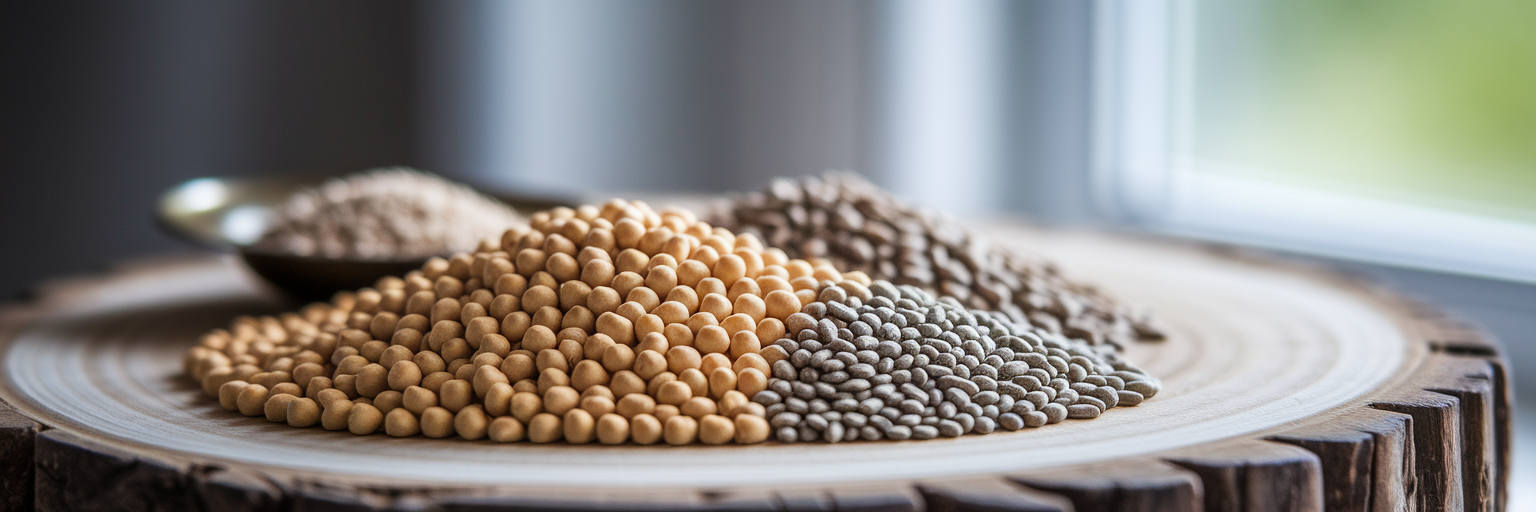That satisfying ache you feel a day or two after a challenging workout is a sign of progress. It tells you that you pushed your limits and your muscles are adapting. This feeling has a name: Delayed Onset Muscle Soreness, or DOMS. It’s the direct result of microscopic tears in your muscle fibres, an essential part of the process that makes them stronger. Your body’s natural response is to initiate inflammation to begin repairs. While this healing process is necessary, excessive or prolonged inflammation is what causes the stiffness and discomfort that can sideline you.
The goal isn’t to eliminate this response entirely but to manage it effectively. By supporting your body’s recovery, you can get back to your training sooner and with less discomfort. Learning how to reduce muscle soreness after workout sessions starts with understanding what your body needs to repair itself efficiently. This is where the right nutrition, particularly your protein source, plays a critical role in moderating inflammation and accelerating recovery.
Understanding Post-Workout Muscle Soreness
That satisfying ache you feel a day or two after a challenging workout is a sign of progress. It tells you that you pushed your limits and your muscles are adapting. This feeling has a name: Delayed Onset Muscle Soreness, or DOMS. It’s the direct result of microscopic tears in your muscle fibres, an essential part of the process that makes them stronger. Your body’s natural response is to initiate inflammation to begin repairs. While this healing process is necessary, excessive or prolonged inflammation is what causes the stiffness and discomfort that can sideline you.
The goal isn’t to eliminate this response entirely but to manage it effectively. By supporting your body’s recovery, you can get back to your training sooner and with less discomfort. Learning how to reduce muscle soreness after workout sessions starts with understanding what your body needs to repair itself efficiently. This is where the right nutrition, particularly your protein source, plays a critical role in moderating inflammation and accelerating recovery.
The Anti-Inflammatory Power of Plant-Based Proteins

When we talk about recovery, the conversation often centres on protein’s role in rebuilding muscle. However, not all proteins approach recovery in the same way. One of the standout benefits of plant-based proteins is their inherent ability to help manage inflammation. The connection between plant based protein inflammation reduction is rooted in the natural compounds found in their sources, like peas, hemp, and soy. These plants are packed with phytochemicals and antioxidants that actively work to soothe your system after a tough workout.
According to research published in the Nutritional Journal, diets rich in plant-derived compounds can help lower key inflammatory markers in the body. This is a distinct advantage over animal-based proteins like whey, which, while effective for muscle synthesis, lack these built-in anti-inflammatory agents. Intense exercise produces free radicals, unstable molecules that cause cellular stress. Plant proteins deliver compounds that help neutralize them.
Key anti-inflammatory agents found in plant sources include:
- Polyphenols: These powerful compounds are abundant in plants and help counteract the oxidative stress generated during exercise.
- Flavonoids: A specific type of polyphenol that plays a role in regulating the body's inflammatory pathways, helping to keep the healing response balanced.
- Antioxidants: Vitamins and other compounds that protect your cells from damage, supporting a quicker and more comfortable recovery.
By choosing a vegan protein, you are not just fueling muscle repair. You are also providing your body with the tools it needs to calm the inflammatory response that contributes to soreness.
Amino Acids for Effective Muscle Repair
A common question about vegan protein is whether it can truly compete with whey for muscle repair. The concern often comes down to amino acids. Think of amino acids as the essential building blocks your body uses to reconstruct and strengthen muscle tissue after exercise. There are nine essential amino acids (EAAs) that your body cannot produce on its own, so they must come from your diet. These are the critical components needed for effective recovery.
The myth that plant proteins are "incomplete" is outdated. While a single plant source might be lower in one or two EAAs, modern vegan protein powders solve this by blending complementary sources. For example, combining pea protein (rich in lysine) with rice protein (rich in methionine) creates a robust and complete profile of amino acids for muscle repair. Research in the American Journal of Clinical Nutrition confirms that these plant protein blends are highly effective at stimulating muscle protein synthesis.
One of the most important amino acids for recovery is leucine, which acts as a trigger for the mTOR pathway, the body's primary signal for muscle growth and repair. High-quality vegan protein blends are specifically formulated to deliver a potent dose of leucine and other branched-chain amino acids (BCAAs), ensuring your muscles get the signal to start rebuilding immediately. This makes them a powerful and equally effective alternative for anyone serious about their fitness goals.
Timing Your Protein for Optimal Relief

You have finished your last set, and your muscles are primed for recovery. What you do next can make a significant difference in how you feel tomorrow. This brings us to the concept of the "anabolic window," the period roughly 30 to 60 minutes after your workout when your muscles are most receptive to nutrients. Consuming protein during this window helps kick-start the repair process and can blunt the inflammatory response before it fully takes hold.
Knowing the best time to take protein is one thing, but making it a consistent habit is what truly matters. Research highlighted in Sports Medicine supports that post-exercise protein intake is crucial for optimizing muscle repair and adaptation. An easy way to ensure you never miss this window is to prepare your protein shake before you even start your workout. Having it ready to go means you can drink it immediately after your cool-down, flooding your muscles with the nutrients they need right when they need them most.
This simple habit is easier to maintain when your protein is enjoyable and convenient. A smooth, non-chalky formula like our Chocolate Vegan Protein mixes easily with water or plant-based milk, making your post-workout ritual something you actually look forward to.
Vegan Protein Versus Whey for Recovery
The debate over which protein is superior for recovery is ongoing, but the answer depends on what you value. Whey protein has long been popular for its rapid absorption and high concentration of leucine. It is effective for stimulating muscle protein synthesis, and there is no denying its role in the fitness world. However, a holistic approach to recovery reveals a more complete picture where vegan protein offers distinct advantages.
For many people, plant-based proteins are simply gentler on the digestive system. Since they are dairy-free, they eliminate the risk of bloating, gas, and discomfort that can affect those with lactose sensitivity. Beyond personal comfort, there is the environmental benefit. Plant-based proteins have a significantly lower carbon footprint, requiring less water and land than dairy-based whey production.
The crucial difference in the vegan vs whey protein recovery discussion lies in the dual benefits of plant protein. You get the high-quality amino acid profile needed for muscle repair, combined with the natural anti-inflammatory compounds that actively help reduce soreness. Whey focuses on one job, while vegan protein does two. For a more comprehensive overview of different options, you can explore our guide to the best protein powders.
| Factor | Vegan Protein | Whey Protein |
|---|---|---|
| Inflammatory Response | Actively reduces inflammation via phytochemicals | Neutral; lacks inherent anti-inflammatory compounds |
| Digestibility | Generally easier to digest, less bloating (dairy-free) | Can cause digestive issues for those with lactose sensitivity |
| Amino Acid Profile | Complete profile achieved through blending (e.g., pea & rice) | Naturally high in leucine and BCAAs |
| Sustainability | Lower environmental footprint (land, water, emissions) | Higher environmental impact due to dairy farming |
| Holistic Benefits | Supports muscle repair and overall wellness | Primarily focused on muscle protein synthesis |
Enhancing Recovery Beyond the Protein Shake

A high-quality protein shake is a cornerstone of effective recovery, but it works best as part of a complete strategy. To maximize the benefits of a vegan protein for muscle recovery, consider what else you can add to your post-workout routine. Pairing your shake with other nutrient-dense, anti-inflammatory foods creates a powerful synergistic effect that can accelerate healing and further reduce soreness.
Think of your shake as the foundation and these additions as recovery boosters:
- Tart Cherries: Known for their ability to reduce muscle pain and inflammation, they make a great addition to a smoothie.
- Turmeric & Black Pepper: The curcumin in turmeric is a potent anti-inflammatory, and its absorption is enhanced by the piperine in black pepper.
- Leafy Greens: A handful of spinach or kale adds a dose of antioxidants and micronutrients without altering the taste of your shake.
By adopting a holistic approach, you empower your body to recover faster and more completely. For inspiration on how to combine these ingredients, check out these 3 easy vegan protein recipes that are as delicious as they are effective.



